Please Take Note: This is a review of the final game, but it might change slightly based on the success of the Kickstarter campaign. The game is being reviewed on the components and the rules provided with the understanding that “what you see is not what you might get” when the game is published. If you like what you read and want to learn more, we encourage you to visit the game publisher’s website or visit the Kickstarter campaign. Now that we have all that disclaimer junk out of the way, on with the review.
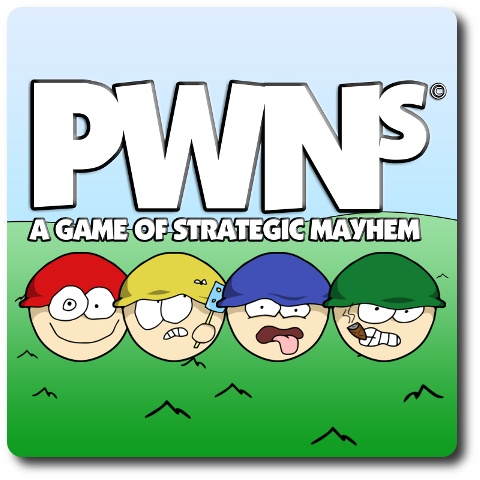
The Basics:
- For ages 8 and up (publisher suggests 10+)
- For 2 to 4 players
- Approximately 45 minutes to complete
Geek Skills:
- Active Listening & Communication
- Counting & Math
- Logical & Critical Decision Making
- Reading
- Strategy & Tactics
- Risk vs. Reward
- Hand/Resource Management
Learning Curve:
- Child – Easy
- Adult – Easy
Theme & Narrative:
- Take to the battlefield and PWN your opponent’s pawns
Endorsements:
- Gamer Geek rejected!
- Parent Geek mixed!
- Child Geek approved!
Overview
A pawn is used and abused for the greater good. Sometimes the pawn is aware of this and sometimes not. In either case, it never goes well for the pawn. But what if the pawns were given weapons and the freedom to make their own choices? Once power is given, it’s difficult to take back. Especially is you are trying to arrest power from a pawn holding a bazooka.
PWNs: A Game of Strategic Mayhem, designed by Ryan Boyle and to be published by Awry Games, will reportedly be comprised of 1 game board, 72 cards, 60 Terrain tiles, 16 PWN pieces, 16 Character cards, 16 Character card stands, 16 Health tokens, 5 Starter tiles, and 1 standard six-sided die. As this is a review of a prepublished game, I cannot comment on the game component quality. The illustrations by Ryan Boyle are cute, depicting the characters in the game as pea-sized warriors wearing what is either a combat helmet or a winter cap. Hard to say. In either case, the illustrations do a great job of adding a bit of humor to the game and visually demonstrating the mayhem on the battlefield.
Note: The game’s title, “PWNs”, is a play on words. To “PWN” someone during a game is to effortlessly dominate and beat them. You can “PWN” someone or be “PWNed”. A “PWN” is also short of “pawn”, the least valued piece in Chess that is prized for being highly expendable.
On a Chess Board Like No Other
To set up the game, first place the game board in the middle of the playing area. Have each player sit on one of the four sides of the square board.
Second, have each player select their favorite color and give them the matching colored Character cards and PWN pieces (with plastic stands). Place any unused Character cards, PWN pieces, and plastic stands back in the game box.
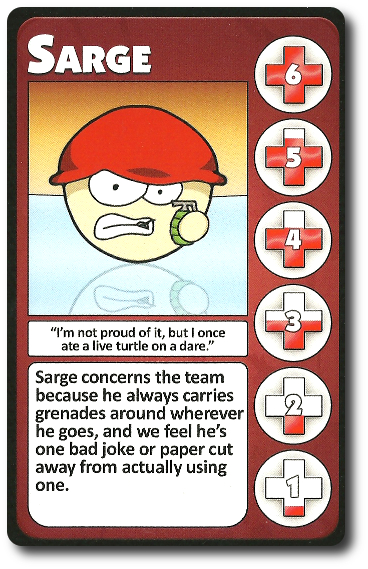
Example Character card
Third, either select at random or decide as a group what 4 Starter tiles to use. The Starter tile is a 4×4 grid that depicts different types of terrain. Place them on the game board, setting any unused Starter tiles back in the game box.
Fourth, each player now places their 4 Character cards in front of them and adds a Health token to each of their Character cards, placing it on the “5” space.
Fifth, have each player place their PWN pieces on the game board in any of the 10 starting squares known as the player’s “Home Zone”. Only 1 PWN piece per square.
Sixth, shuffle the cards and deal each player a set number of cards, face-down. The number of cards dealt is based on the number of players. For example, in a 2-player game, each player would be dealt 5 cards each and in a 4-player game, each player would be dealt 3 cards each. This is the player’s starting hand and cards should remain hidden until played. The number of cards initially dealt also determines the default hand size limit. Place the remaining deck of cards face-down to create the draw deck. Leave room for a discard pile.
Seventh, place the Terrain tiles and die off to one side and within easy reach of the players.
That’s it for game set up. Determine who will go first and begin.
Pawn PWN’age
PWNs is played in rounds and turns with no set number of rounds per game. Some effects in the game only last a single player’s turn or an entire round, which is measured in a complete cycle of all the players’ turns. On a player’s turn, they will complete a sequential number of phases. A player’s turn is summarized here.
Phase 1: Draw and Move
The first thing a player does on their turn is draw a card and add it to their hand. They then have 3 moves they can split among their PWN pieces however they choose. Each move must be to an adjacent square. Each square moved into counts as 1 move. This means a player can move 1 PWN piece 3 times or even 3 PWN pieces 1 square each. Totally up to the player.
While a player is unable to move diagonally, they can move into squares that contain hazards and even move into a square occupied by another PWN piece. The Terrain types the players move their PWNs through and around are not safe territory.

Terrain can be changed and influenced, slowing the PWN piece down and causing damage. The different Terrain types include:
- Dirt: A benign terrain and safe from fire.
- Grass: Beautiful and green, but also susceptible to fire (among other things). If the Grass tile is burned, it will turn to dirt.
- Dray Grass: Brown, dry, and easy to ignite. If the Grass tile is burned, it will turn to dirt.
- Water: A hazard found on the battlefield that will cause confusion, chaos, and loose of health.
In addition, there are conditional effect that can target the noted terrain above, changing it.
- Ice: Solid water, but when touched by fire, becomes a water hazard.
- Fire: Hot! Hot! Hot! Lasting for only 1 round of game play, but capable of changing terrain, as well as sizzling PWN pieces.
- Hole: These nasty obstacles will swallow a PWN piece whole. Any PWN piece that falls in never comes out. Worse yet, Hole terrain is permanent.
If a PWN piece moves into a square already occupied by another PWN, the terrain is ignored. Instead, a “Collision” occurs and is resolved. Both PWN pieces suffer damage (recorded on the player’s Character cards) and then the PWN piece that previously occupied the square is moved to an adjacent square. The player who moved the PWN piece in occupies the square. After that, the Terrain type takes effect if need be. It’s possible that the shifting of PWN pieces due to a “Collision” will cause a chain reaction, causing multiple “Collisions”. No matter the result, a PWN piece cannot be pushed off the game board, but they most certainly can be pushed into fire, water, and even holes.
Some cards will restrict a PWN piece movement. For example, being tied up by grass or being frozen solid. If such a condition inflicts a PWN piece, they cannot move and might not even be able to defend themselves or be healed.
Phase 2: Take Action
The player now selects 1 PWN piece and announces they are taking an action with it. However, if the player caused a “Collision” during phase 1, they cannot take any action with that specific PWN piece. When playing cards, players should keep track of which cards affect the entire “team”. A “team” refers to all the PWN pieces the player currently has in play.
The player can play 2 different cards at this time. These are are “Elemental” and “Attack” cards.
Attack Cards
“Attack” cards allow players to engage in combat. “Attack” cards focus on movement and melee attacks, projectiles (ranged attacks) and special. Combat attacks are pretty straight forward, with the player’s PWN piece needing to be adjacent to the target. Projectiles have a range and a line of sight, meaning the player will have to think a bit more about who they want to attack and how best to target them (you can hit and damage a friendly PWN piece!). Special “Attack” cards are resolved per the instructions on the card.
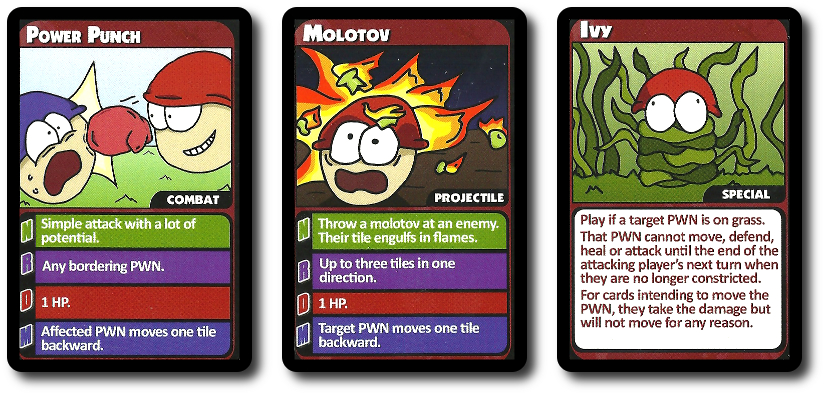
Most “Attack” cards will also have a summary of the attack itself, noted at the bottom. These display Notes, the Range, the Damage inflicted, and any forced Movement.
Elemental Cards
“Elemental” cards are board game changers, both in the literal in figurative sense. Once played, a new Terrain tile is placed, changing the previous terrain. This means the Starter tile terrain is temporary and subject to change on the whim of a player.
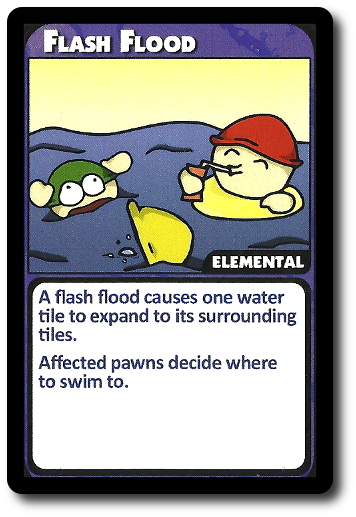
React Cards
While not playable on the player’s turn, the “React” cards allow a player’s opponent to duck, dodge, counter, and do other special moves to avoid being hit or harmed. “React” cards can only be used at certain times and must be played before any die rolls. However, a player is never required to play a “React” card if they do not want to. Additionally, there is no limit to the number of “React” cards that can be played.
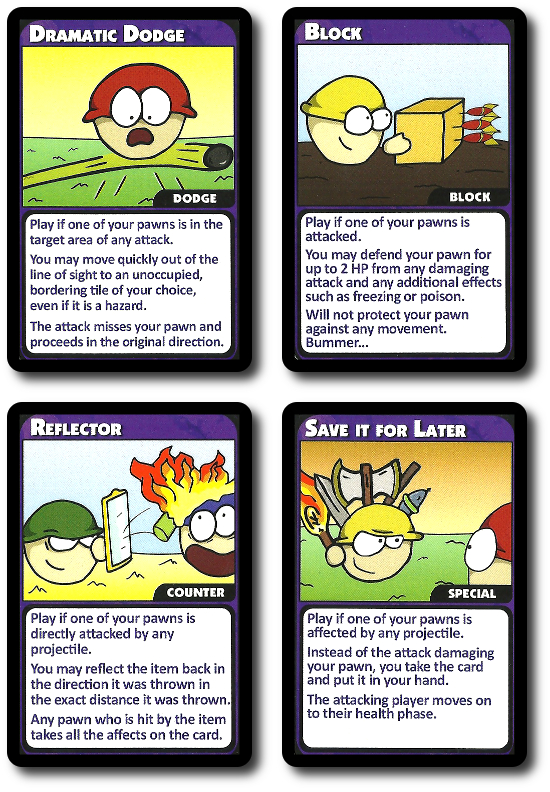
Phase 3: Health
If the player has a “Health” card, they can play 1 now. This will allow the player to heal 1 or more PWNs, adjusting the Health token accordingly. If a PWN piece is ever KO’ed (killed), they are out of the game, which is a bad thing. PWN pieces can also be removed from the game if they fall down a “Hole” Terrain type. Health is tracked on the Character cards. Since Character cards are visible to the player and the player’s opponents at all times, it’s very easy to see which PWN piece is hurting the most.
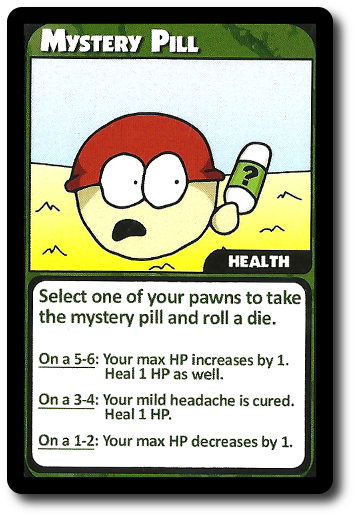
This completest the player’s turn. The next player in turn order sequence now goes.
PWN’ing the Pawns
The game continues as described above, with new Terrain tiles being placed, PWN pieces being strategically moved about, and cards being played to add a tactical advantage, until only 1 player’s PWN pieces remain. This player has won the game.
House Rules
PWNs is very easy to modify if you want to start on different terrain or set up scenarios based win conditions. The only aspect of the game that cannot be changed are the cards which are necessary to leave as-is to ensure the game play is balanced. Not the case for terrain. We tried several different ways to play the game, including a game variant we called “King of the Hill”, where we only used 1 4×4 grid in a 2-player game. Totally brutal, quick, and fun.
To learn more about PWNs: A Game of Strategic Mayhem, visit the game publisher’s website or visit the Kickstarter campaign.
Final Word
The Child Geeks had fun with the game, finding it to be the right mix of chaos and entertainment to keep them engaged, but not for the duration of the game. According to one Child Geek, “When the game first starts, it’s a lot of fun because there are a lot of pieces to interact with. As the game keeps going, it becomes harder and harder to knock out your opponent.” The Child Geeks is absolutely correct. A player’s opponent can “run” from the battle, if they like, making it difficult to engage with the enemy. However, as the game progresses, it goes from a brawl to a shooting match. This was not lost on one Child Geek who said, “I like how the game changes over time. The terrain changes how you attack and how you go about playing . I think it’s a neat game.” When the games were over, the Child Geeks agreed that PWNs was a game they enjoyed, but only every once in a while. As one Child Geek put it, “The game is fun, but wow, it can take a lot to win.”
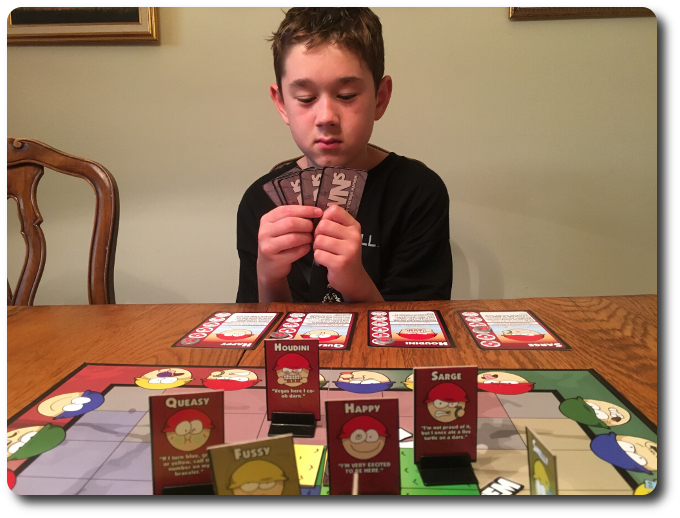
Playing the “King of the Hill” game variant my oldest son created – exceedingly brutal, fast, and fun
The Parent Geeks found PWNs to be a bit of a hassle at first, as they attempted to attack their opponents certain ways, but were unable to due to not having the right cards. According to one Parent Geek, “I always get frustrated with games that limit what I can and cannot do based on the random cards I get. I don’t really feel like I’m playing, but am rather just making a choice based on what I am provided.” Another Parent Geek said, “I really like how the terrain changes and the game keeps shifting, but I don’t know if I have the cards to keep up.” Again and again, I kept hearing about the cards and how they were limiting. One Parent Geek, however, had a different idea. He said, “Like a real battlefield, everything changes. Unlike a real battle, I cannot make changes on the fly, but nor can my opponents. This creates an interesting challenge and one that I find entertaining.” When the votes were in, the Parent Geeks were mixed when it came to approving the game.
The Gamer Geeks were not fans. According to one Gamer Geek, “I do not care for games that limit me and tell me what I can and cannot do based on the cards I am randomly provided in the game. Victory doesn’t got to the better player. Victory goes to the luckier player.” The Gamer Geeks really didn’t like that healing PWNs was based on a card that they may or may not have, either. According to one Gamer Geek, “Super. I lost because I didn’t have a card that is in the discard pile.” It was not all doom and gloom. The Gamer Geeks liked how the terrain changed, how certain conditions changed the landscape, and the level of tactical and strategic play that was involved. However, it always came back to the cards. As one Gamer Geek put it, “A game that asks its players to be strategic and tactical needs to give them the ability to pivot on short notice, take risks, and retreat as needed. Everything I can do this turn is based on the 4 cards in my hand. That is the very definition of limiting.” When the votes were in, the Gamer Geeks rejected PWNs.
It’s difficult to strike a balance with games that require opponents to be eliminated in order to win. A game must provide its players the ability to make quick decision, act, react, and learn as they go. PWNs provides their players this ability, but the extent of which is determined by the cards they are provided. A game that can only be won through actions needs to give the players access to those actions. As it stands with PWNs, the actions are printed on cards that may or may not be in the player’s hand.
And therein lies the game’s true challenge. The landscape shifts, but a player may not be able to react the way they want to initially. The cards in their hand will allow them to do “something”, but what? The player must review, reason, and deduce which card to play that will provide the maximum benefit. Do they attack the opponent on their left or keep their team together for a stronger offensive? This game is played in the moment. The only goal is to exterminate and any actions taken that further that goal are the right choice.
Let us also keep in mind that the game is short and not meant to be a direct replacement for larger and more complicated Wargames. PWNs has enough tongue-and-cheek to make it obvious that the game is not meant to be played with a serious face. There is much to consider and game play is meaningful, but in a light-hearted way. I found it to be a good example of a game you can play with younger and inexperienced players, introducing them to games that require much more focus. If you are looking for a game where battles and victory are won using a bit of luck and a bit of strategy, do give PWNs: A Game of Strategic Mayhem a try. While you might be playing with pawns, you’ll feel like a king or a queen when you win.
This is a paid for review of the game’s final prototype. Although our time and focus was financially compensated, our words are our own. We’d need at least 10 million dollars before we started saying what other people wanted. Such is the statuesque and legendary integrity of Father Geek which cannot be bought except by those who own their own private islands and small countries.



